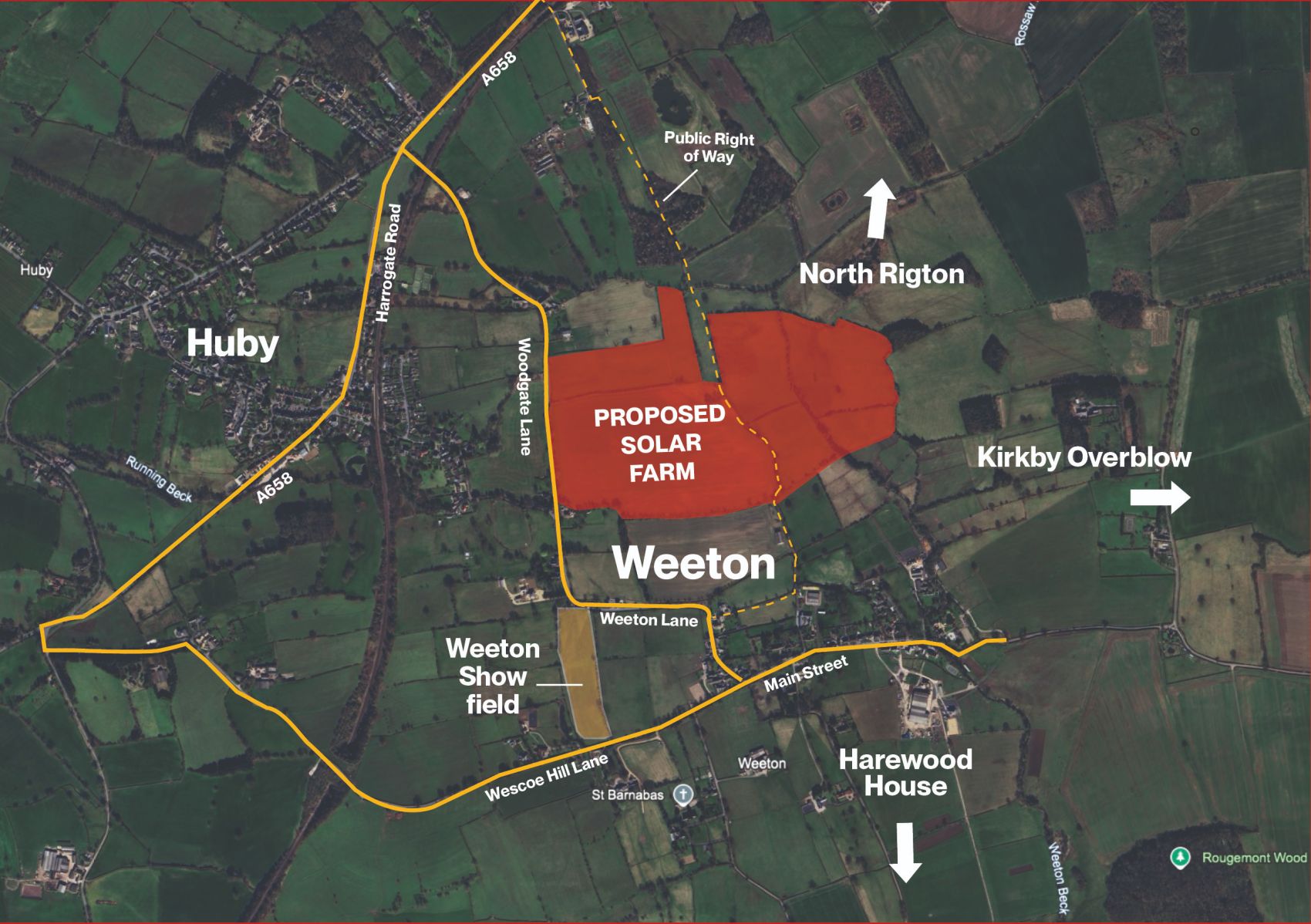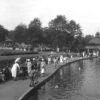The proposed Juniper Solar Farm near Weeton has sparked significant local debate, and the formation of a group to oppose the development, “Stop Weeton Solar Farm”
The proposed development is around 15-minutes from Harrogate.
Project Overview
- Developer: Abei Energy UK
- Location: Farmland north of Weeton village, adjacent to Weeton Lane and Woodgate Lane
- Size: ~35.2 hectares (about 86 acres)
- Capacity: 15.4 MW solar PV + 5 MW battery energy storage
Benefits
- Powers up to 7,251 homes during peak hours
- 95% of land remains usable for sheep grazing
- £60,000 community benefit over the project’s lifetime
Community Response
- Objections: Over 375 formal objections submitted to North Yorkshire Council
- Concerns:
- Visual impact on the scenic Lower Wharfedale valley
- Loss of productive farmland
- Lack of grid access and infrastructure delays
- Perceived prioritization of profit over local interests
- Opposition Group: “Stop Weeton Solar Farm” advocates for rooftop or brownfield solar instead
Planning Status
- Environmental Impact Assessment deemed unnecessary
- Public consultations held in early 2025
- Planning application made in mid 2025, with a decision likely in early 2026
General and landscape Issues
Stop Weeton Solar Farm:
The development will be twice the size of the village, result in the loss of productive agricultural land, involve heavy construction vehicles accessing the site along single track roads and will greatly affect the spectacular views across the valley from the surrounding area.
The landscape of the Lower Wharfedale valley is renowned for its beauty, inspiring sketches by JMW Turner and has remained relatively untouched by any large scale development to date.
However, a local farmer in the village of Weeton has now done a deal with a Spanish developer ABEI Energy to build a solar development of well over 80 acres on green belt farmland at Juniper Farm.
The solar site, which dwarfs the size of the village, will include tens of thousands of solar panels, 3.66 metres (12 feet) high, plus associated battery energy storage systems (BESS) – housed in shipping container-sized units, transformer stations, inverter cabins, a meteorological station, 2.5 metre high security fencing and CCTV.
However, there is no proposal for a connection to the national grid, which calls in to question the deliverability of the scheme.
The site will be clearly visible from Almscliffe Crag, Harewood House, The Chevin, Eccup and Healthwaite Hill, significantly affecting the visual amenity of the whole area for visitors and residents alike. Screening will be impossible as the development will sit in a low lying valley, overlooked by the surrounding areas on all sides.
The village of Weeton is set in an intimate and scenic landscape where there is a strong sense of tranquillity. Residents are now struggling to sell their homes and have further concerns over fire risks, threats to the local wildlife and the degradation of a much loved footpath that runs right through the centre of the proposed site.
Bernie May from Stop Weeton Solar Farm, said:
The development will change the whole character of Weeton forever and will quite literally be a blot on the landscape.
What’s also extremely concerning is that ABEI Energy are already contacting other local farmers in the area to try to extend the development once they have approval for Juniper Farm. This is a common tactic by developers – basically, one solar farm opens the flood gates for more in the area.
Abei Energy response on Landscape issues:
The application will be determined by the Council on the planning balance, and whilst we have always accepted that there will be inevitably some degree of visual impact, this has been mitigated by the relatively low height of the development and the location of
existing and proposed trees, hedgerows and landscape features such as existing buildings.The development will also be set well back from the roads and pathways.
There will be no loss of trees and overall, there will be measured ecological improvements.
The planning balance includes many material planning considerations including the need to meet net zero targets and to combat climate change of which the Council have already
Grid Connection
Abei on the grid connection:
The suggestion that there is no grid connection is not accurate. A formal grid connection offer was issued and accepted by Northern Powergrid, the local Distribution Network Operator, in 2023. The connection point lies on the Bramham SP – Menston SP 33kV
overhead line interconnector circuit.The offsite grid connection works do not form part of the submitted planning application, which is standard practice.
The connection from the site to the agreed Point of Connection will be designed and constructed by the developer’s appointed Independent Connection Provider (ICP), with Northern Powergrid undertaking tdertaking the non-contestable works.
Bernie May from Stop Weeton Solar Farm said:
This application is not about reaching net zero, it is about maximising profit.
Developers want to use farmland as it’s cheaper, quicker and easier for them – with more profit for both the developer and the landowner.
Roof top solar and brownfield site developments are the answer, in line with national planning policy, yet this is currently not being adhered to.
The opposition group is not against renewable energy, but believe we should learn from others such as Germany who, in 2023 alone, installed 14GW of new solar capacity – quickly and efficiently – predominantly using rooftop space (almost 70%).
In France, all car parks with more than 80 spaces must have solar installed. In contrast, UK lobby groups such as house builders have forced governments to back away from solar panels on all new builds. The former Department of Energy and Climate Change estimated that there were 600,000 acres of south facing commercial roof-space in the UK. So why use precious farmland and green belt?
Furthermore, the National Grid admitted in February 2024 that they have nearly 400GW of projects in the connection pipeline across our UK networks, which is over five times the amount needed to meet the UK Government’s 2035 decarbonised electricity system commitment.
Perhaps most importantly is that according to recent government figures, solar power is the worst performing renewable energy generator in the UK, struggling to reach a little over 10% efficiency in the last 5 years, which will come at a cost of around 2% of UK cropland by 2030 and the associated risks to food security.
Food security and loss of farmland
Stop Weeton Solar Farm on Food security:
Claims from the developer that the Juniper Farm land is unproductive, are not borne out by the fact that this land has been used for grazing, hay and arable crops for hundreds of years.
This development will form part of the 100,000 acres of land that is being taken out of cultivation each year, the majority of which is being lost to solar farms.
Grazing an unspecified number of sheep under and around the panels is just an empty gesture and in no way compensates for the lost potential of the land.
The land is degraded as half of it will be in permanent shadow and rain water run-off creates set channels without proper dispersal. Topsoil is removed and cleaning materials can contaminate the soil, plus there is the possibility of toxic chemicals leaching out from damaged or defective panels in to the soil and local waterways.
A recent Lancaster University study of solar facilities in England and Wales shows that soil covered by solar panels suffers from the effects of decreased sunlight and the change in microclimate.
Soil becomes compacted, leading to issues with water infiltration and root growth. Other negative impacts relate to nutrient cycling and soil properties.
Abei on comment on the viability of the land as Agricultural Land:
The land has been independently assessed as being Grade 4 agricultural land. This means that it is not classified as Best and Most Versatile Agricultural Land (BMVAL which is Grade 1 to 3a. Grade 3b, 4 and 5 is not BMVAL).
It is important to note that even BMVAL land can still be use for solar farms providing there is a continued tandem agricultural use such as sheep grazing in and around the panels. There have been many LPA decisions and appeal decisions approving such combined uses.
At Juniper Farm, whilst it is Grade 4, our proposal is a similar tandem agricultural use and therefore the site will never lose its agricultural status in terms of its current town planning land use.
At a national level, the National Planning Policy Framework (the Framework) is an important material consideration. In particular:
Paragraph 168 sets out that when considering all forms of renewable and low carbon energy developments and their associated infrastructure, local planning authorities should not require applicants to demonstrate the overall need for renewable energy,
and give significant weight to the benefits associated with renewable energy and the proposal’s contribution to a net zero future.Paragraph 187 indicates that planning decisions should contribute and enhance the natural and local environment by, amongst others, protecting and enhancing soils and recognising the wider benefits from natural capital and ecosystems services including the economic and other benefits of the BMVAL.
Paragraph 188 of the Framework indicates that plans should allocate land with the least environmental or amenity value, and at footnote 65 states that where significant development of agricultural land is demonstrated to be necessary, areas of poorer quality land should be preferred to those of a higher quality.
The proposal at Juniper Farm would not result in the loss of agricultural land whether it is BMVAL or not. This is because the land would continue to be used for agricultural purposes, and at the end of its operational life, it can reasonably and easily be returned
to sole agricultural uses.The need for the proposed development has been clearly established – especially at a national level and need for renewable energy is not disputed by the LPA.
The land would continue to have agricultural activities taking place on it which can be secured by condition; such as the use of a condition requiring a grazing management plan. It is also possible to secure the lands return to sole farming use at the end of its operational life by planning condition.
Highways and Road Safety
Stop Weeton Solar Farm on Road safety:
If the development is allowed to go ahead, the construction will take around 12 months to complete, with large construction vehicles accessing the village along narrow lanes with only passing places to allow cars to travel in both directions.
Low bridges mean the vehicles will have to come right through the village. The lanes and the village are regularly and frequently used by cyclists, horse riders, walkers and bird/wildlife watchers alike, raising significant concerns over safety. T
here will be further future disruption at regular intervals in the development’s current 40 year lifespan, as solar panels will be quickly out dated and regular full scale refitting will be required.
Abei on Highways
During the construction phase, AE UK Solar Project VII Ltd recognise that there will be some disruption to local residents and road users, but we will work closely with the Council to minimise any impact.We have proposed planning conditions to restrict construction hours to reasonable times in order to limit noise and disturbance for nearby residents, including those living along the access routes to and from the site.
A designated construction traffic route has been proposed, and restrictions can be placed on the size of delivery vehicles.
Appropriate signage will be installed, and traffic management measures used where necessary. The route from the A road will be
photographically surveyed before and after construction, ensuring that any damage to road surfaces or verges can be identified and repaired.
Biodiversity and ecology
Stop Weeton Solar Farm on Biodiversity claims are misleading:
ABEI’s assertion that biodiversity will be improved is another area of contention. Biodiversity is of critical importance, but the abstract metric used to measure Biodiversity Net Gain(BNG) is flawed according to ecologists, as it only accounts for direct impacts on habitats within the footprint of a development, it does not protect species and is not a substitute for expert ecological advice.
In fact, ecologists believe that the BNG metric could lead to a biodiversity net loss.
They recommend that much more research and evidence is required before it can be stated that there will not be a significant adverse biodiversity impact from solar farms. Consequently, it would be premature to give approval for solar farm schemes, as after a few years considerable ecological damage could be achieved that would be difficult to correct.
Current advice from ecologists is therefore to site solar farms away from any areas of value.[10] This view is supported by Natural England, “solar PV developments negatively impact birds, bats, mammals, insects and plants. The lack of evidence relating to the ecological impact of solar farms is concerning.
Impact data accompanying the application, has already identified 58 breeding bird species on the Juniper Farm site – 12 categorised of the highest level of conservation concern by BOCC (Birds of Conservational Concern) such as Song Thrush, Curlew, and Fieldfare and a further 18 species classed as amber.
Bats are another protected species and known bat roosts are adjacent to the site. It has been proven that bat activity is significantly reduced around solar farms and the reflective surfaces of solar panels can interfere with bat echolocation, making it difficult for them to navigate and forage effectively.
Covering the land with thousands of glass panels and metal, plus increased human activity will pose a direct threat to local flora and fauna through habitat loss, noise disturbance, and long-term ecological imbalance.
Clearly, planting a few trees, hedges and wild flowers on the site will not compensate for the effect over the whole area.
Transitory animals have their traditional routes blocked. Deer are often diverted onto roads.
Bird and bat deaths are common as they mistake the glass for water. Habitats that local wildlife depend on are displaced or fragmented and access to traditional feeding, nesting or breeding grounds are lost.
Abei on BNG/ Ecology:
The Council Ecology Officer has agreed to the ecology and biodiversity net gain information that has been submitted.
The proposal would exceed the 10% measurable biodiversity net gain as sought by Policy (this would be in the region of +20.39 net gain
for habitat Units, +19.54 for hedgerows and +10.51% for river units.)This means the proposed solar farm will result in an overall ecological improvement compared with the current agricultural use.
Independent evidence also shows that existing, long- established solar farms have delivered measurable benefits to site ecology.
Fire risks and noise pollution
Stop Weeton Solar Farm on Fire risks & Noise pollution:
Numerous international and national incidents have demonstrated that BESS installations pose significant risks to human life, animal welfare, and the environment.The hundreds of Lithium-ion batteries packed closely together in BESS installations can cause ‘thermal runaway’ where just one faulty cell can set off a self-sustained chain reaction that results in ‘battery fires’ which emit toxic and flammable gasses which in turn initiate further fires and explosions.
Such incidents have led to calls for further examination of these systems, including from North Yorkshire County Council who announced their own review earlier this year, yet Juniper Farm will now be ruled on before such an assessment is carried out, despite its close proximity to residential houses in Weeton.
Over four years ago, a study in to the safety of BESS appealed for Health & Safety Executive (HSE) to consider BESS under the Control of Major Accident Hazards Regulations 2015, intended to safeguard public health, property and the environment.[13] Just last month, Richard Dumbar, Managing Director of Park Lodge International Ltd, known for its expertise in fire investigation and emergency response training, outlined a proposed draft standard for BESS which states the requirement for residential houses should be at least one mile from such units and villages at least 5 miles away.
The Juniper Farm solar development will be completely contrary to these recommendations.
Noise pollution is another factor that concerns local residents. The installation is proposed less than 50m from several homes in a village characterised by its tranquil, rural setting with low ambient noise. BESS infrastructure, particularly inverters, transformers and cooling systems, can produce persistent low-frequency hums and tonal noise, often exacerbated during peak cooling operations.
Weeton villagers and other walkers who visit the area are also upset by degradation of the public right of way which runs through the middle of the proposed development. What is now a beautiful footpath through open country side will become enclosed and fenced off on either side and close to the noisy elements of the scheme. Locals came together to walk the footpath over the weekend and demonstrate their strength of feeling over the loss of the walk as they know it.
Forty years does not constitute temporary use.
The application represents a large-scale industrial energy project in a rural setting and would result in the permanent transformation of productive agricultural land into energy infrastructure, yet ABEI claim it will be a temporary development of 40 years.
This is contrary to comments made in the Appeal in respect of a solar farm at Imolands Farm, Lymington, Hampshire, ‘The Secretary of State takes the view that 30 years is a considerable period of time and the reversibility of the proposal is not a matter to which he has given any weight. He considers that a period of 30 years would not be perceived by those who frequent the area as being temporary and that the harmful effect on the landscape would prevail for far too long’.
Nevertheless, solar farms like Juniper Farm continue to be described as temporary developments in planning applications.
Furthermore, the 40 year lease can be extended – as can the size of the site – and developers are not obliged to return the land to its previous productive agricultural use.
There is no guarantee that these companies will still be in business in 40 years’ time, let alone be continuing to maintain the land.
Bernie May said:
This development, and others like it, is not going to be a quick fix for reaching net zero.
ABEI doesn’t even have access to the national grid as it stands, which will take years and will require more infrastructure and upheaval for the village.
If this proposal goes ahead, we will be giving over productive farmland and our countryside to foreign companies who are just out to make huge profits, with no guarantee of it ever being even capable of operation.
Abei on Noise:
A noise impact assessment has been undertaken by an independent specialist which
concludes that noise levels will be minimal. Similarly, a planning condition could be
added requiring noise mitigation measures in relation to the BESS and/or on-site
substation, and/or solar inverter/transformer stations is considered reasonable in order
to minimise the aural impact of the proposal on the occupiers of residential dwellings
and to visitors to the area. In addition, with regards to the construction phase, a
condition is suggested that restricts the hours of construction to between certain times
in order to minimise the noise and other disturbance on nearby residential dwellings
and their occupiers; including those located on roads into and out of the site to the
wider highway network.
Abei on Fire Risk:
AE UK Solar Project VII Ltd take the minimising the risk of fire very seriously.
There are currently about 1900 working BESS developments operating in the UK.
Of these operating BESS developments, only one (Carnegie Road, Liverpool) has known to have caught fire back in 2020. Since then, the development of BESS sites has had additional fire precaution measures employed including cut off systems and automatic fire suppressant systems.
There are also now measures installed on site to aid the fire service in the unlikely event of a fire.
Engagement with the public
We also questioned around their engagement process with the local residents.
Abei said on engagement:
The two public engagement sessions were attended by around 110 people.
Information was also shared with parish councils, ward councillors, and the local MP.
More than 300 invitations were sent to residents in Weeton and the surrounding area, and several site notices were displayed, each linking to the project website.
The Council is now carrying out its own notification process in relation to the submitted planning application.
Since the planning application has been submitted, all documents and drawings will be available through the Council’s planning portal. This ensures there is a single, reliable source of information and avoids any confusion that might arise from duplicate websites. sitessites.
Members of the public should refer only to the Council’s website for accurate and up-to-date information. The application reference is 25/02219/FULMAJ, which can be viewed on North Yorkshire Councils planning application website
Julian Smith MP was asked for comment, but did not respond.







